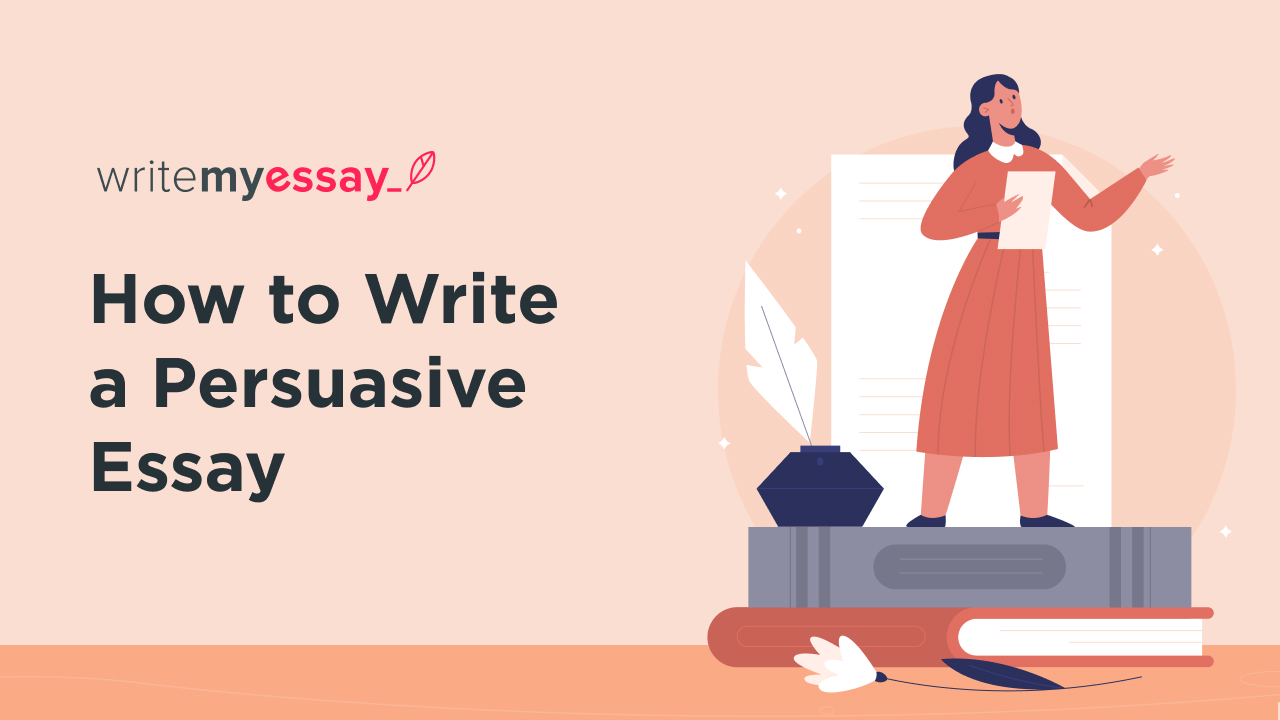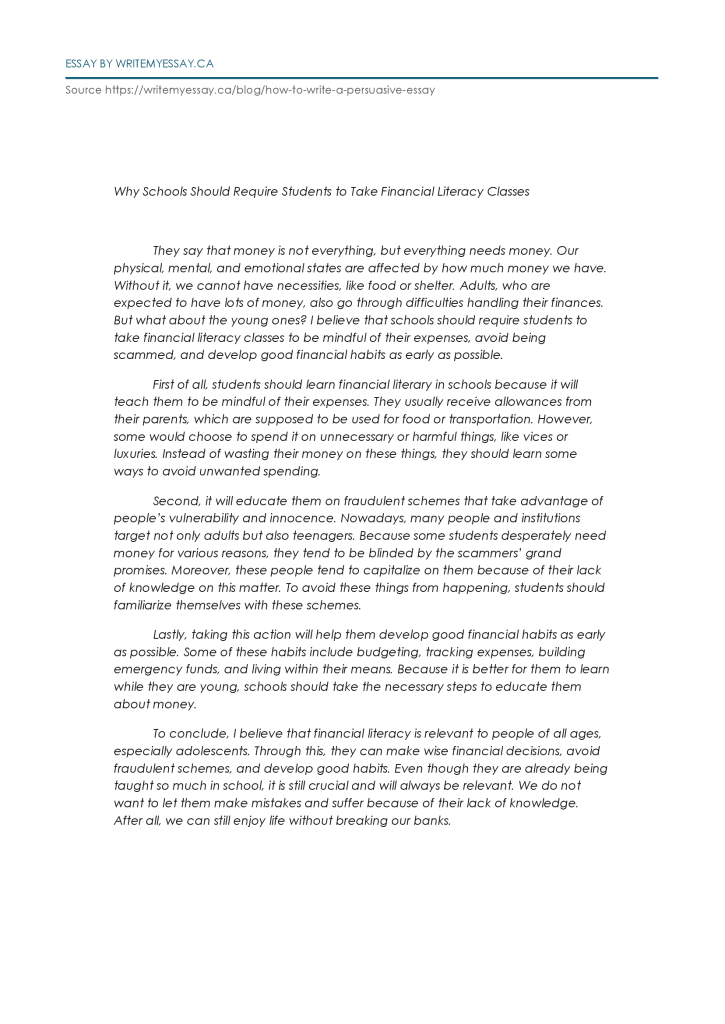
How to Write a Persuasive Essay

Table of Contents
- What Is a Persuasive Essay
- Why It Is Important to Know How to Write Persuasive Essay
- How to Write an Outline
- How to Start a Persuasive Essay
- How to Write Body Paragraphs
- Tips to follow in writing Persuasive Essay
- Short Example of Persuasive Essay
- Common Mistakes to Avoid While Writing Persuasive Essay
Trying to convince your friends to do you a favor is not easy. You usually enumerate the instances you helped them or even developed a deal to make them agree. Little did you know that you are already applying the principles of writing a persuasive essay using emotions and attachments. However, making a structured piece is a different issue. This article will know more about how to write a persuasive essay through tips and examples.
What Is a Persuasive Essay?
Many people are still confused about the differences between argumentative and persuasive essays. Knowing their distinct qualities can help you write an essay of the correct kind. While they may have similarities in structure, they differ in terms of purpose and strategies.
Argumentative essays are meant to give logical reasons why their claim is valid. Writers usually use an informative or neutral tone in this kind of work because their goal is only to present arguments and evidence. They also rely heavily on researches to give relevant supporting details.
On the other hand, persuasive essays use facts and emotions to convince the readers to agree with the given opinion. Writers are more emotional or aggressive in expressing their ideas. Moreover, they do not acknowledge the contradicting notion; instead, they focus solely on their side. This kind of structure is typically used in political campaigns or advertisements.
Why It Is Important to Know How to Write Persuasive Essay
Your teacher has instructed you to submit a persuasive essay, but you do not know why learning how to do it is vital. It is not a rare scenario. Some educators focus on giving activities to finish the curriculum without explaining the real-life application of their lessons. Like any other lesson, learning how to write this kind of output will benefit you in the future for multiple reasons.
This writing task allows students like you to formulate opinions freely. Also, it strengthens and hones your writing and reasoning skills, which you can use in your daily interactions. Lastly, it encourages you to reflect on your words’ influence on people, especially using the internet and social media. Without understanding how persuasive essays can be impactful, people will keep on using them to their advantage without regard to others’ feelings and opinions.
How to Write an Outline
Some students prefer to start writing their paper without outlining. They think that the time used on this step can be allocated for drafting instead. However, they do not know how vital outlines are. No matter which kind you use, they help you develop a more organized and cohesive output. They ensure that you have a clear direction and that all your goals are met in the end.
The teachers typically recommended the standard outline because it is easy to use. While other experts may suggest more effective methods, it is enough for someone just learning about this. Below is an example of a standard persuasive essay outline.
Introduction:
- Start with a “hook” to get your readers’ attention
- Give some background information about the topic
- Thesis statement with at least three main points
I. First reason to support your position on the issue
- A topic sentence explaining your first main point
- Example or evidence as supporting details
- Clincher to conclude
II. Second reason to support your position on the issue
- A topic sentence explaining your second main point
- Example or evidence as supporting details
- Clincher to conclude
III. Third reason to support your position on the issue
- A topic sentence explaining your third main point
- Example or evidence as supporting details
- Clincher to conclude
Conclusion:
- Restate your thesis statement
- Summary of main points or reasons
- Call to action or recommendation
How to Start a Persuasive Essay
One of the most challenging steps in doing any writing task is to start. Before writing a persuasive essay introduction, you need to consider several things. It includes your interests, personal opinions, resources, and limitations. These things will help you come up with an excellent persuasive essay topic and formulate your thesis statement. However, first, you need to brainstorm what you want to discuss and determine your stand on the issue. Then, list down at least three main reasons people should agree on your opinion and change theirs.

Afterward, you have to think of a relevant hook that will capture your readers’ attention. You can use a personal story, shocking information, or inspirational quote. Whichever you use should help you catch their attention, which will make them read the entire work.
How to Write Body Paragraphs
Once you have determined your thesis statement, you can fill in the body parts of the outline. You will use that input to have a clear flow of ideas as your write the body paragraphs. As evident in the persuasive essay structure above, you must divide this section into three different paragraphs. It is to dedicate one for each main point for a more organized flow of insights.
The first thing you need to do is start with your topic sentence, which is supposed to explain your claim. Afterward, follow it up with supporting details, a combination of examples, narratives, or facts. Lastly, wrap the body paragraph with a clincher or closing remarks. You can follow the same format for the entire body as long as you can defend your thesis at the end.
How to Write Conclusion for a Persuasive Essay
After drafting all the other parts, you can now conclude your essay. To do this effectively, you have to summarize your main points and how they proved your claim. Then, restate your thesis statement so that the reader can assess whether you defended your claim well. Also, this is essential for you to re-emphasize your opinion on the issue. Finally, you end close with a call to action or suggestion addressed to the reader, concerned people, or society. You should impact your reader and achieve your ultimate goal through your conclusion – to change their views.
Tips to follow in writing Persuasive Essay
The tips on how to complete the introduction, body, and conclusion given above can already help you. However, there are some that you can use to make the entire process convenient or the final output outstanding. Below are eight tips that you can follow in writing a persuasive essay.
- Make a schedule from brainstorming to editing.Search for topics for persuasive essays online.
- Put the most impactful point in the last body paragraph.
- Use transitional devices, such as “moreover,” “nevertheless,” or “likewise.”
- Maximize the use of your outline while drafting.
- Use quotes from famous people to connect with the reader’s interest.
- Find a way to connect with the reader’s emotions using pathos.
- Proofread and edit. Repeat until flawless.
Short Example of Persuasive Essay

Indeed, it is challenging to learn without examples or references. Below is a persuasive essay example that you can refer to as you write your own.
Why Schools Should Require Students to Take Financial Literacy Classes
They say that money is not everything, but everything needs money. Our physical, mental, and emotional states are affected by how much money we have. Without it, we cannot have necessities, like food or shelter. Adults, who are expected to have lots of money, also go through difficulties handling their finances. But what about the young ones? I believe that schools should require students to take financial literacy classes to be mindful of their expenses, avoid being scammed, and develop good financial habits as early as possible.
First of all, students should learn financial literary in schools because it will teach them to be mindful of their expenses. They usually receive allowances from their parents, which are supposed to be used for food or transportation. However, some would choose to spend it on unnecessary or harmful things, like vices or luxuries. Instead of wasting their money on these things, they should learn some ways to avoid unwanted spending.
Second, it will educate them on fraudulent schemes that take advantage of people’s vulnerability and innocence. Nowadays, many people and institutions target not only adults but also teenagers. Because some students desperately need money for various reasons, they tend to be blinded by the scammers’ grand promises. Moreover, these people tend to capitalize on them because of their lack of knowledge on this matter. To avoid these things from happening, students should familiarize themselves with these schemes.
Lastly, taking this action will help them develop good financial habits as early as possible. Some of these habits include budgeting, tracking expenses, building emergency funds, and living within their means. Because it is better for them to learn while they are young, schools should take the necessary steps to educate them about money.
To conclude, I believe that financial literacy is relevant to people of all ages, especially adolescents. Through this, they can make wise financial decisions, avoid fraudulent schemes, and develop good habits. Even though they are already being taught so much in school, it is still crucial and will always be relevant. We do not want to let them make mistakes and suffer because of their lack of knowledge. After all, we can still enjoy life without breaking our banks.
Common Mistakes to Avoid While Writing Persuasive Essay
Mistakes are inevitable in any learning process. However, we can minimize them by knowing what to avoid beforehand. Below are common mistakes to avoid while writing a persuasive essay.
- You are choosing an unarguable topic. Remember that other people should be able to argue, refute, or contest your stand. It should not be a known fact, or else there is no point in persuading others.
- It is not on outlining before writing. As mentioned previously, you need to outline first to organize and arrange your insights accordingly. Use the sample persuasive essay format for future references.
- It is not on providing the appropriate evidence to defend the claim. In your attempt to finish drafting early, you might have included some supporting details that do not match the main point. You can avoid this by doing more rigorous research to widen your sources.
- It is not proofreading or editing. You must not skip this step because you might miss out on some significant mistakes that could have been avoided.
In conclusion, there are so many things that you should remember before writing a persuasive essay. You have to know its format, content, and purpose. Because it is closely similar to an argumentative essay, you have to read persuasive essay examples to observe their differences. However, it would be best if you use it to impact the people around you and our world positively.


